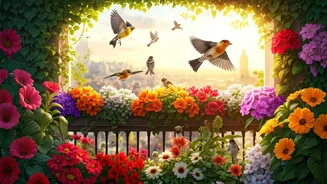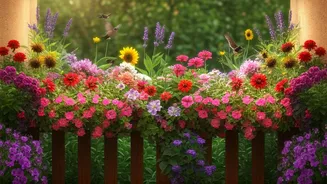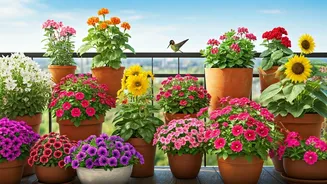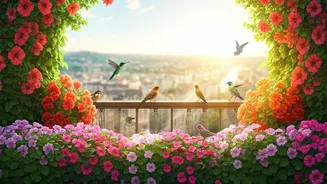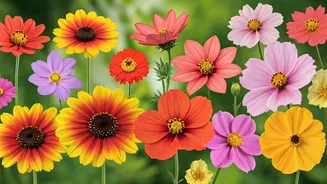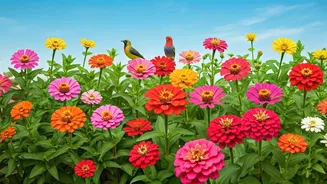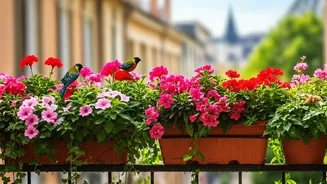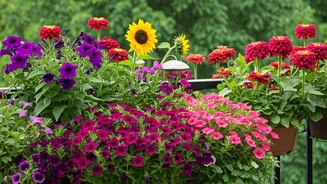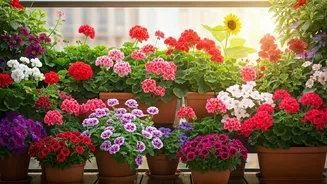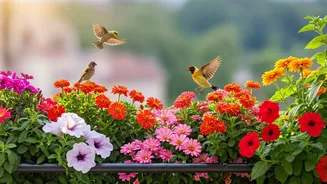Sunflowers: A Delight
Sunflowers, with their towering presence and sunny faces, are a fantastic choice. These annuals are easy to grow, providing seeds that birds adore. Plant
them in pots with well-draining soil and plenty of sunlight. As the flowers mature, they produce seeds, becoming a dining table for finches, sparrows, and other small birds. Ensure you position your sunflowers to offer both shelter and easy access to the seeds. Regular watering and protection from strong winds will also help your sunflowers thrive, ensuring a bountiful harvest for both you and your avian visitors. The vibrant yellow petals also add a splash of color to your balcony.
Marigolds: Pest-Repellent Beauty
Marigolds are known for their cheerful appearance and ability to repel pests, making them a dual advantage for your balcony garden. These resilient annuals come in various shades of orange, yellow, and red. They are relatively low-maintenance, requiring only moderate watering and plenty of sunlight. Marigolds also attract insects, which, in turn, can draw insect-eating birds like wrens and warblers to your balcony. Position marigolds in pots or hanging baskets to create colorful borders. Ensure adequate spacing and well-draining soil to prevent root rot, and deadhead spent blooms to encourage continuous flowering throughout the season. These flowers add a layer of natural pest control to the space.
Petunias: Colorful Cascade
Petunias are a classic choice for balconies, offering a cascading display of color. These annuals bloom prolifically in various colors, from vibrant purples and pinks to whites and blues. They thrive in hanging baskets and containers, needing at least six hours of sunlight per day. To encourage flowering, regularly deadhead spent blooms, and water them consistently. Petunias don't directly feed birds, but their bright colors attract insects, which then attract birds. The trailing nature of petunias also provides some shelter for small birds. Choose a mix of colors to create a visually appealing display, and consider using a slow-release fertilizer to support vigorous growth.
Coneflowers: Pollinator Paradise
Coneflowers, also known as Echinacea, are excellent for attracting pollinators, including bees, butterflies, and, indirectly, birds. These perennials have striking daisy-like flowers in shades of purple, pink, and white. They prefer full sun and well-drained soil. As the flowers fade, they produce seed heads that attract finches and other seed-eating birds. Plant them in larger containers to accommodate their size. Coneflowers are relatively low-maintenance, requiring only occasional watering once established. The seeds are a significant food source. Additionally, the sturdy stems and seed heads offer shelter during inclement weather, making them a beneficial addition.
Zinnias: Burst of Color
Zinnias are annuals that offer a dazzling array of colors, perfect for brightening any balcony. These easy-to-grow flowers come in various sizes and shapes, providing continuous blooms throughout the summer. They thrive in full sun and well-drained soil. They are known for attracting butterflies and other insects, which, in turn, entice insectivorous birds. Plant zinnias in pots or window boxes, and ensure adequate watering. Deadheading spent blooms will also encourage the plant to produce more flowers. Consider a mix of zinnia varieties to create a colorful display. The constant blooms will make it look vibrant and attract more species.
Nasturtiums: Edible Delight
Nasturtiums offer beauty and utility, as both their flowers and leaves are edible. These annuals have vibrant flowers in shades of orange, yellow, and red. They are easy to grow, preferring full sun but tolerating partial shade. While they don't directly attract birds, nasturtiums host insects that birds will eat. Plant them in hanging baskets or containers, providing well-drained soil and moderate watering. Their peppery taste adds a unique flavor to salads. The trailing nature of nasturtiums also provides some cover for small birds. The flowers' attractive colors and unusual foliage will enhance your balcony.
Lavender: Fragrant Attraction
Lavender's fragrant blooms and attractive scent will add a sensory dimension to your balcony, as well as attract bees. This perennial thrives in full sun and well-drained soil. While lavender doesn't directly feed birds, it attracts bees and other insects that provide a food source. Plant lavender in pots with plenty of sunlight, and water sparingly, as it doesn't like overly wet conditions. The scent of lavender can also deter mosquitoes, adding another benefit to your balcony garden. Prune lavender regularly to encourage a bushier form and continuous flowering, making the balcony visually appealing.
Salvia: Hummingbird Magnet
Salvia, with its vibrant spikes of flowers, is a hummingbird magnet, making it a wonderful addition to any bird-friendly balcony. These perennials and annuals come in various colors, with red, purple, and blue being the most attractive to hummingbirds. They thrive in full sun and well-drained soil. The tubular shape of the flowers makes them perfect for hummingbird feeding. Plant salvia in pots or hanging baskets. Regular watering and deadheading will encourage more blooms, keeping the balcony alive. Make sure the location has adequate sunlight to ensure the plants thrive.
Pansies: Cheerful Blooms
Pansies are a great choice for adding some cheer to your balcony. These annuals come in various colors and patterns. They thrive in cooler temperatures and prefer partial shade in warmer climates. They attract some insects that provide a food source for birds. Plant pansies in pots or window boxes. Provide well-drained soil and regular watering. Deadheading spent blooms will also encourage them to keep blooming. Their cheerful colors and ease of care make them a great choice for beginner gardeners. The range of colors makes it look lively.
Cosmos: Delicate Beauty
Cosmos are elegant annuals that add a touch of delicate beauty to your balcony garden. With daisy-like flowers in shades of pink, purple, white, and yellow, they attract butterflies and other pollinators, indirectly attracting birds. They are easy to grow, preferring full sun and well-drained soil. Plant cosmos in pots or containers and deadhead regularly to encourage continuous blooms. Their lightweight nature adds a graceful movement to the balcony. The seeds from the plants can also provide a food source for some small birds, which will enhance the balcony environment.
